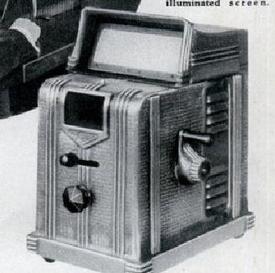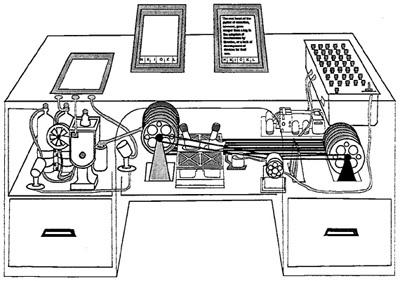This week we celebrate the ebook. The last few years have
seen a drastic change in the publishing industry thanks to the growing
popularity and convenience of this simple invention.
 |
| 1923 Optigraph |
But ebooks aren’t something new fangled. They’ve been around
for a very long time. In 1923 the International Filmbook Corporation patented an
early microfilm reader, the Optigraph Reading Machine. Books were photographed onto microfilm and wound into cartridges that were inserted into the machine and the image mirrored and reflected onto the reading glass. Readers moved through the pages turning a crank on the side of the machine.
In 1936 ‘canned libraries’ were introduced in the form of a
microfilm reader called the Teledex. Books and other media were put into
cartridges the size of a 12-gauge shotgun shell that was inserted into the
machine and the ‘filmbook’ projected onto a screen for reading. The idea of this canned library was to save space for schools and smaller community libraries.
 |
| 1936 Teledex |
In 1945 scientist Vannevar Bush introduced the world to his
idea for condensing entire libraries into one machine called a Memex. In his Atlantic
Monthly article, As We May
Think, he describes the method in which books and other media are
compressed onto microfilm. Bush says, “Consider a future device for individual
use, which is a sort of a mechanized private file and library. It needs a name,
and, to coin one at random, “memex” will do. A memex is a device in which an individual
stores all his books, records, and communications, and which is mechanized so
that it may be consulted with exceeding speed and flexibility. It is an
enlarged intimate supplement to his memory.”
As computers developed into more efficient storage devices
inventions such as the 1968 DynaBook. The DynaBook looked like a giant Kindle
with a grayscale screen and keyboard. Books or documents stored on the 2lb
device could be read. Later, Toshiba would use this design to create one of the
first laptops.
I’m sure early librarians, authors, and readers went through
the same emotions and conflicts over their precious volumes being squished into
these shotgun shell cartridges that we have felt in recent years with the
explosion of the ebook market.
 |
| 1968 DynaBook |
Filmbooks and ebooks will never be able to fully
take the place of a print book. After all the elevator hasn’t taken out the
necessity of stairs. Even in Star Trek they still collected and coveted their
printed volumes. The ebooks and ereaders are just another way of enjoying the
timeless stories we’ve always loved. Aren't you glad you can sit on the beach
and relax with your Kindle or Nook instead of pulling out your Optigraph or
Telex?
In celebration of Read an Ebook Week, my books Don’t Touch
and Half will be 50% off on Smashwords March 3rd - 8th.
Just use the code REW50 at checkout to get your discount off my and other
fantastic reads this week.
 |
| 2014 Kindle Paper White |
My ebook reading this week will be finishing up the Numbers
Game by John Stanley then Dark Murders Collection by Carolyn McCray and Ben
Hopkins. So what ebook are you reading? Do you prefer ebook or print book? How do you read your ebooks?


No comments:
Post a Comment
Thanks for stopping by and for your comment!